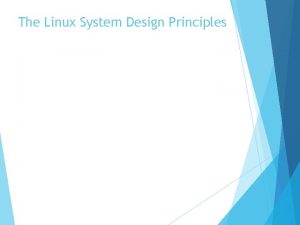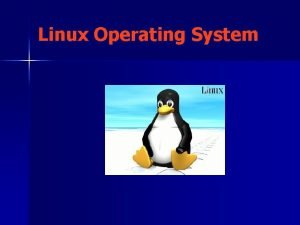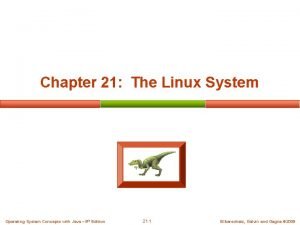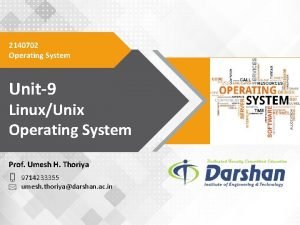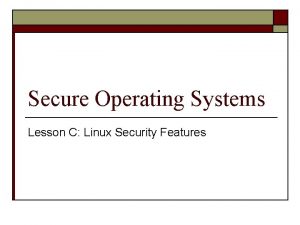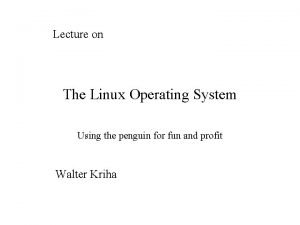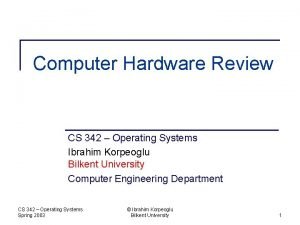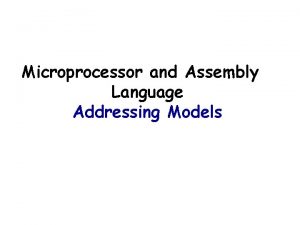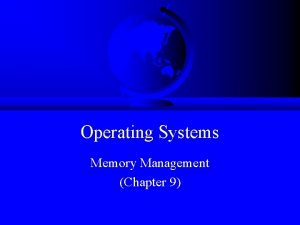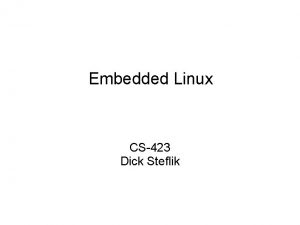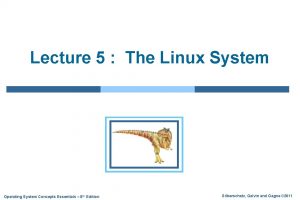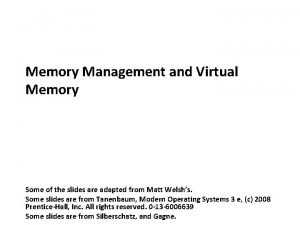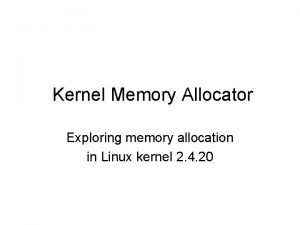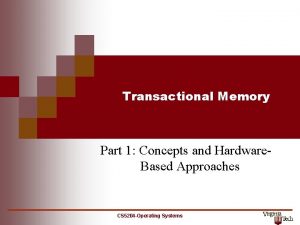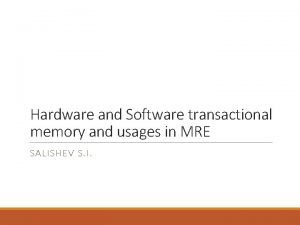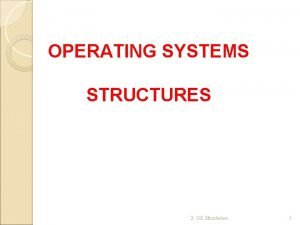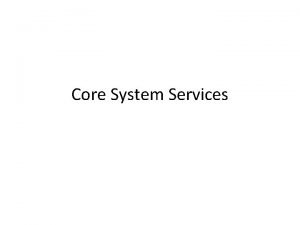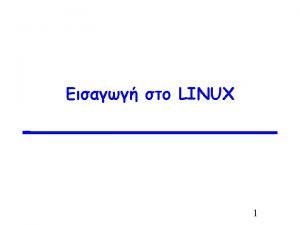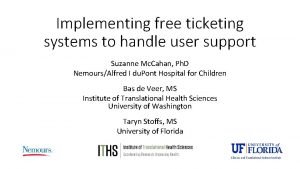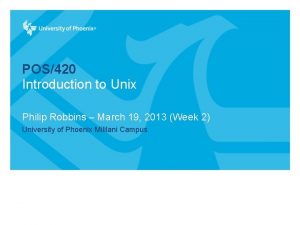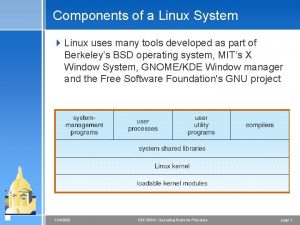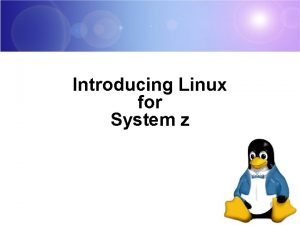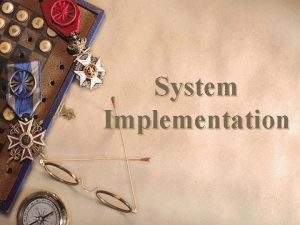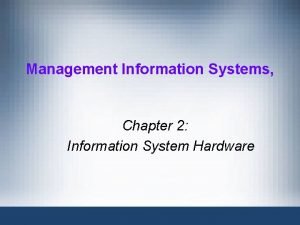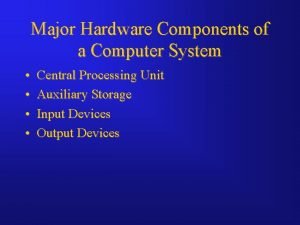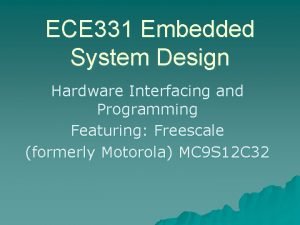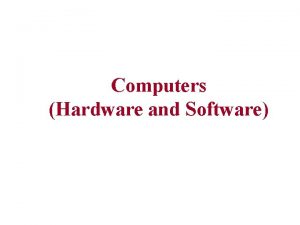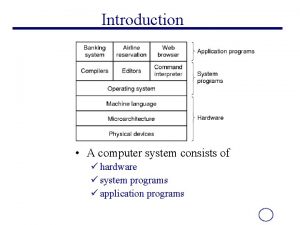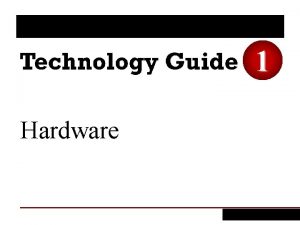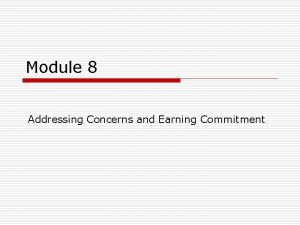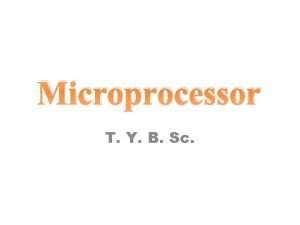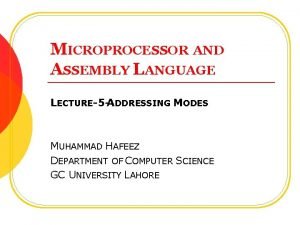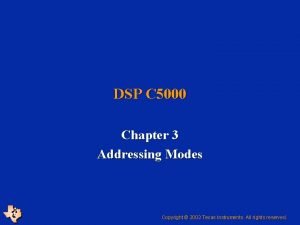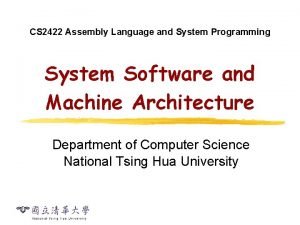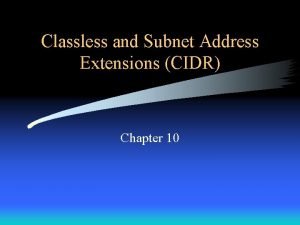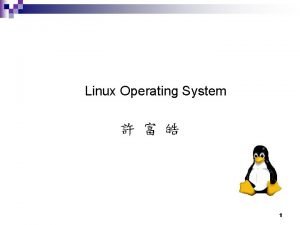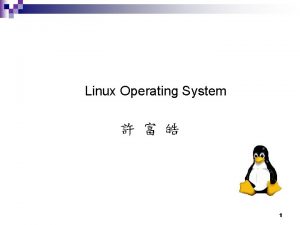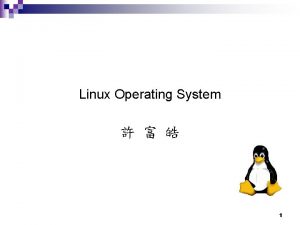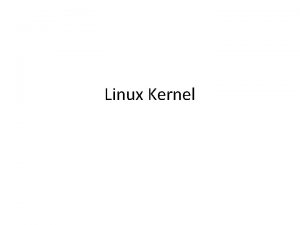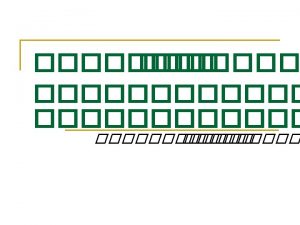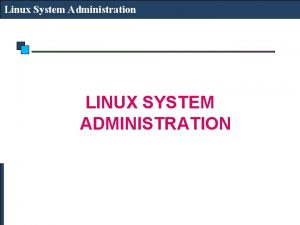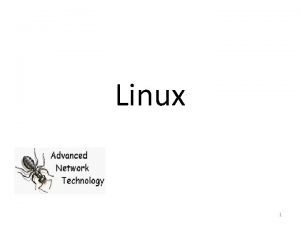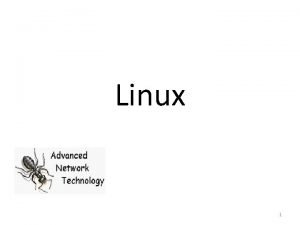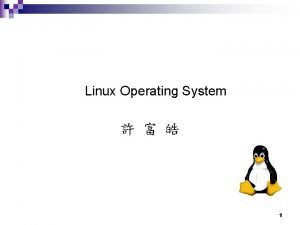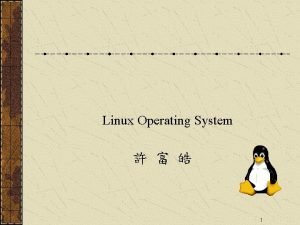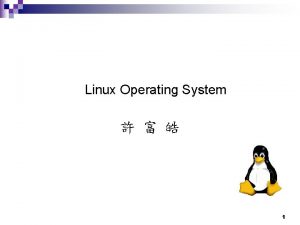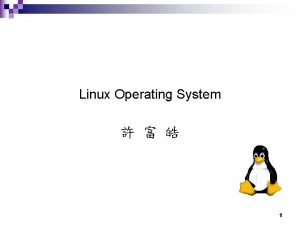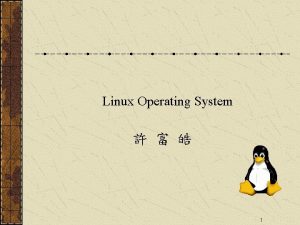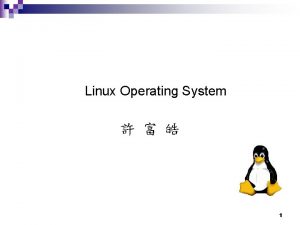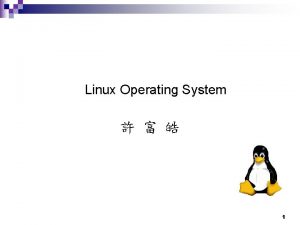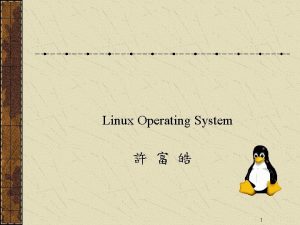Linux Operating System 1 Memory Addressing 2 Hardware



















![PWT & PCD vs. CD [csie. NTU] n n PWT flag: If the CD PWT & PCD vs. CD [csie. NTU] n n PWT flag: If the CD](https://slidetodoc.com/presentation_image_h/24aaed41408c0b8688fd8d331ec2a58f/image-20.jpg)











![Linux page table Layout [yrj] 32 Linux page table Layout [yrj] 32](https://slidetodoc.com/presentation_image_h/24aaed41408c0b8688fd8d331ec2a58f/image-32.jpg)












![Descriptor Cache Registers [Robert Collins] n n Whether in real or protected mode, the Descriptor Cache Registers [Robert Collins] n n Whether in real or protected mode, the](https://slidetodoc.com/presentation_image_h/24aaed41408c0b8688fd8d331ec2a58f/image-45.jpg)



![Memory Types [answers. com] 64 k 1 M 49 Memory Types [answers. com] 64 k 1 M 49](https://slidetodoc.com/presentation_image_h/24aaed41408c0b8688fd8d331ec2a58f/image-49.jpg)
![Extended Memory (XMS) [pcguide] n n All of the memory above the first megabyte Extended Memory (XMS) [pcguide] n n All of the memory above the first megabyte](https://slidetodoc.com/presentation_image_h/24aaed41408c0b8688fd8d331ec2a58f/image-50.jpg)
![Access XMS [pcguide] [wiki] n There are two ways that extended memory is normally Access XMS [pcguide] [wiki] n There are two ways that extended memory is normally](https://slidetodoc.com/presentation_image_h/24aaed41408c0b8688fd8d331ec2a58f/image-51.jpg)

![EMS Requirements [pcguide] To use EMS, a special adapter board was added to the EMS Requirements [pcguide] To use EMS, a special adapter board was added to the](https://slidetodoc.com/presentation_image_h/24aaed41408c0b8688fd8d331ec2a58f/image-53.jpg)
![Expanded Memory [wikipedia] n n Expanded Memory was a trick invented around 1984 that Expanded Memory [wikipedia] n n Expanded Memory was a trick invented around 1984 that](https://slidetodoc.com/presentation_image_h/24aaed41408c0b8688fd8d331ec2a58f/image-54.jpg)
![Memory Allocation in a PC [CDE] 55 Memory Allocation in a PC [CDE] 55](https://slidetodoc.com/presentation_image_h/24aaed41408c0b8688fd8d331ec2a58f/image-55.jpg)
![I/O Ports [text book] n n Each device connected to the I/O bus has I/O Ports [text book] n n Each device connected to the I/O bus has](https://slidetodoc.com/presentation_image_h/24aaed41408c0b8688fd8d331ec2a58f/image-56.jpg)
![I/O Related Instructions [text book] Four special assembly language instructions called in, ins, out, I/O Related Instructions [text book] Four special assembly language instructions called in, ins, out,](https://slidetodoc.com/presentation_image_h/24aaed41408c0b8688fd8d331ec2a58f/image-57.jpg)
![I/O Shared Memory [text book] n n n I/O ports may also be mapped I/O Shared Memory [text book] n n n I/O ports may also be mapped](https://slidetodoc.com/presentation_image_h/24aaed41408c0b8688fd8d331ec2a58f/image-58.jpg)



![Default Physical Addresses Used by Kernel [1] n n The Linux kernel is installed Default Physical Addresses Used by Kernel [1] n n The Linux kernel is installed](https://slidetodoc.com/presentation_image_h/24aaed41408c0b8688fd8d331ec2a58f/image-62.jpg)








- Slides: 70

Linux Operating System 許 富 皓 1

Memory Addressing 2

Hardware Cache n There is a significant speed gap between ¨ the CPU speed (could be several gigahertz) and ¨ memory access speed (maybe only hundreds of clock cycles which run at 66 MHz). n Based on the locality principle, a high speed memory called cache is build inside the CPU to store recently accessed data or instructions; hence, when a CPU is going to access data or instructions, it can check the cache first before it access the main memory to get the items. 3

Cache Page n Main memory is divided into equal pieces called cache pages. ¨A cache page is not associated with a memory page in page mode. The word page has several different meaning when referring to a PC architecture. n The size of a cache pages is dependent on ¨ the size of the cache and ¨ how the cache is organized. 4

Cache Line n n A cache page is broken into smaller pieces, each called a cache line. The size of a cache line is determined by both ¨ the processor and ¨ the cache design. n n A cache line is the basic unit of data transferred between the main memory and CPU. Usually a line consists of a few dozen of contiguous bytes. 5

Relationship between Cache Pages and Cache Lines 6

How to Find Whether the Content of Certain Address Is inside a Cache? n Cache controller ¨ Stores an array of entries, one entry for each line of the cache memory. ¨ Each entry contains a tag and a few flags that describe the status of the cache line. n If the content of a physical address is stored inside the cache, the CPU has a cache hit; otherwise, it has a cache miss. 7

Processor Hardware Cache 8

Hardware Cache Types n According to where a memory line is stored in the cache, there are three different types of caches: ¨ Fully associative. ¨ Direct mapped. ¨ Degree N-way set associative. 9

Fully Associative n n Main memory and cache memory are both divided into lines of equal size. This organizational scheme allows any line in main memory to be stored at any location in the cache. 10

Direct Mapped n n Direct Mapped cache is also referred to as 1 -Way set associative cache. In this scheme, main memory is divided into cache pages. The size of each page is equal to the size of a cache. Unlike the fully associative cache, the direct map cache may only store a specific memory line of a cache page within the same cache line of the cache. 11

Degree N-way Set Associative n n A set-associate scheme works by dividing the cache SRAM into equal sections (2 or 4 sections typically) called cache ways. The cache page size is equal to the size of the cache way. A memory line w of a cache page can only be stored in the cache line w of one of the cache ways. 12

Cache Type Summary ¨ Fully associative: a memory line can be stored at any cache line. ¨ Direct mapped: a memory line is always stored at the same cache line. ¨ Degree N-way set associative: Cache lines are divided into N sets, a memory line can be in any set of the N sets. But inside a set, the memory line is stored into the same cache line. This is the most popular cache type. 13

After a Cache Hit (Read) For a read operation, the controller read the data from the cache line and transfer it to CPU without any access to the RAM. n In this case the CPU save access time. n 14

After a Cache Hit (Write) n For a write operation, two actions may be taken: ¨ Write-through: the controller write the data into both the cache line and the RAM memory. ¨ Write-back: the controller only change the content of the cache line that contains the corresponding data. n Then the controller writes the cache line back into RAM only ¨ ¨ when the CPU executes an instruction requiring a flush of cache entries or when a FLUSH hardware signal occurs. 15

Control the Cache The CD flag of the cr 0 register is used to enable (0) or disable (1) the cache circuitry. n The NW flag of the cr 0 register specifies whether the write-through or the writheback is used for the cache. n 16

After a Cache Miss (Read) n For a read operation: the data is read from the main memory and ¨ Is stored a copy in the cache. ¨ 17

After a Cache Miss (Write) n For a write operation: the data is written into the main memory and ¨ the correct line is fetched from the main memory into the cache. ¨ 18

An Interesting Feature of the Pentium Cache n It lets an OS associate a different cache management policy with each page frame. ¨ For this purpose, each translation table has two flags PCD (Page Cache Disable) and PWT (Page Write. Through. ) n n n The former specifies whether the cache must be enabled or disable when access data inside the corresponding page frame. The later specifies whether the write-back or the writethrough strategy must be applied while writing data into the corresponding page frame. Linux enables caching and uses write-back strategy for all page frame access. 19
![PWT PCD vs CD csie NTU n n PWT flag If the CD PWT & PCD vs. CD [csie. NTU] n n PWT flag: If the CD](https://slidetodoc.com/presentation_image_h/24aaed41408c0b8688fd8d331ec2a58f/image-20.jpg)
PWT & PCD vs. CD [csie. NTU] n n PWT flag: If the CD flag of cr 0 is set (1), this flag is ignored. PCD flag: If the CD flag of cr 0 is set (1), this flag is ignored. 20

Cache in Multiple Processors n Cache snooping: in a multiple processor system, each processor has its own local cache; therefore, when a processor modifies certain data item in its cache, then all other processors whose caches have the same data item must be notified and modify their corresponding data item also. 21

Translation Lookaside Buffers (TLB) n When a virtual address is used, the paging unit of a CPU transfers it into a physical one and saves the result in its TLB; therefore, next time when the same virtual address is used, it physical address could be obtained directly by accessing the TLB without any modification. ¨ n Using this hardware to save time spending on paging. When the cr 3 of a CPU is modified, the hardware automatically invalidates all entries of local TLB. ¨ Recall that cr 3 control register points to the base address of a page directory. 22

Paging in Linux 23

Level Number of Linux Paging Model n n Linux adopts a common paging model that fits both 32 -bit and 64 -bit architectures. Two paging levels are sufficient for 32 -bit architectures, while 64 -bit architectures require a higher number of paging levels. Up to version 2. 6. 10, the Linux paging model consisted of three paging levels. Starting with version 2. 6. 11, a four-level paging model has been adopted. 24

Type of Linux Translation Tables n The four types of page tables are called: ¨ Page Global Directory ¨ Page Upper Directory ¨ Page Middle Directory ¨ Page Table n This change has been made to fully support the linear address bit splitting used by the x 86_64 platform. 25

The Linux Paging Model 26

Advantages of Paging n n Assign different physical address space to each process. A page could be mapped into one page frame, then after the page frame is swapped out, then the same page could be mapped into a different page frame. 27

4 -Level Paging Model on a 2 -Level Paging System n n n The Pentium uses a 2 -level paging system. Linux uses a 4 -level paging model; however, for 32 -bit architectures with no Physical Address Extension, two paging levels are sufficient. Linux essentially eliminates the Page Upper Directory and the Page Middle Directory fields by saying that they contain 0 bits ¨ The kernel keeps a position for the Page Upper Directory and the Page Middle Directory by setting the number of entries in them to 1 and mapping these two entries into the proper entry of the Page Global Directory. 28

The Linux Paging Model under IA-32 Page Upper Directory Page Middle Directory 29

When Linux Uses PAE Mechanism n n The Linux Page Global Table The Linux Page Upper Table The Linux Page Middle Table The Linux Page Table the 80 x 86’s Page Directory Pointer Table eliminated the 80 x 86’s Page Directory the 80 x 86’s Page Table 30

Processes and Page Global Directories n n n Each process has its own Page Global Directory and its own set of page tables. When a process switch occurs, Linux saves [kkto] the cr 3 control register in the descriptor of the process previously in execution and then loads cr 3 with the value stored in the descriptor of the process to be executed next. Thus, when the new process resumes its execution on the CPU, the paging unit refers to the correct set of page tables. 31
![Linux page table Layout yrj 32 Linux page table Layout [yrj] 32](https://slidetodoc.com/presentation_image_h/24aaed41408c0b8688fd8d331ec2a58f/image-32.jpg)
Linux page table Layout [yrj] 32

Code #define PGDIR_SHIFT 22 #define PTRS_PER_PGD 1024 /* * the pgd page can be thought of an array like this: pgd_t[PTRS_PER_PGD] * * this macro returns the index of the entry in the pgd page which would * control the given virtual address */ #define pgd_index(address) (((address) >> PGDIR_SHIFT) & (PTRS_PER_PGD - 1)) i. e. : 11 1111 33

Code type: pgd_t * #define pgd_offset(mm, address) ((mm)->pgd + pgd_index((address))) static inline pud_t * pud_offset(pgd_t * pgd, unsigned long address) { return (pud_t *)pgd; } static inline pmd_t * pmd_offset(pud_t * pud, unsigned long address) { return (pmd_t *)pud; } 34

Code static void machine_kexec_page_table_set_one( pgd_t *pgd, pmd_t *pmd, pte_t *pte, unsigned long vaddr, unsigned long paddr) { pud_t *pud; pgd += pgd_index(vaddr); : pud = pud_offset(pgd, vaddr); pmd = pmd_offset(pud, vaddr); : : } 35

What is BIOS? n BIOS stands for Basic Input/Output System which includes a set of basic I/O and low-level routines that communicate between the software and hardware and ¨ handle the hardware devices that make up a computer. ¨ n The BIOS is built-in software that determines what a computer can do without accessing programs from a disk. n On PCs, the BIOS contains all the code required to control the keyboard display screen disk drives serial communications and ¨ a number of miscellaneous functions. ¨ ¨ 36

Memory Types of BIOS ROM n Flash memory n ¨ Contents could be updated by software. ¨ Pn. P (Plug-and-Play) BIOSes use this memory type. 37

Address Ranges of BIOSes n The main motherboard BIOS uses the physical address range from 0 x. F 0000 to 0 x. FFFFF. n However some other hardware components, such as graphics cards and SCSI cards, have their own BIOS chips located at different addresses. n The address range of a graphic card BIOS is from 0 xc 0000 to 0 xc 7 fff. 38

Functions of BIOS n Managing a collection of settings for the HDs, clock, etc. ¨ n n The settings are stored in a CMOS chip. A Power-On Self-Test (POST) for all of the different hardware components in the system to make sure everything is working properly. Activating other BIOS chip on different cards installed in the computer, such as SCSI and graphic cards. Booting the OS. Providing a set of low-level routines that the OS uses to interface to different hardware devices. ¨ Once initialized, Linux doesn’t use BIOS, but uses its own device drivers for every hardware device on the computer. 39

Execution Sequence of BIOS n n n n Check the CMOS Setup for custom settings Initialize address Table for the interrupt handlers and device drivers Initialize registers and power management Perform the power-on self-test (POST) Display system settings Determine which devices are bootable Initiate the bootstrap sequence 40

After Turning on the Power…(1) n Power on CPU RESET pin the microprocessor automatically begins executing code at 0 x. F 000: FFF 0. It does this by setting the Code Segment (CS) register to segment 0 x. F 000, and the Instruction Pointer (IP) register to 0 x. FFF 0. ¨ ¨ n real mode. A BIOS chip is also located in the area includes this address. The first instruction is just a jump instruction which jumps to a BIOS routine to start the system startup procedure. 41

After Turning on the Power…(2) n n Check the CMOS setup for custom settings Perform the Power-On Self-Test (POST) ¨ System check: n n n ¨ Test individual functions of the processor, its register and some instructions. Test the ROMs by computing checksum. Each chip on the main board goes through tests and initialization. Peripheral testing: n Test the peripherals (keyboard, disk drive, etc. ) 42

After Turning on the Power…(3) n Initialize Hardware Device: ¨ ¨ ¨ Guarantee that all hardware devices operate without conflicts on the IRQ lines and I/O ports. At the end of this phase, a table of installed PCI devices is displayed. Initialize the BIOS variables and Interrupt Vector Table (IVT). n n The BIOS routines must create, store, and modify variables. It stores these variable in the lower part of memory starting at address 0 x 400 (BIOS DATA AREA (BDA). ) Display system settings Initiate the bootstrap sequence. 43

Physical Memory Layout of a PC physical address range memory type use 0 - 3 FF 0000: 0000 -0000: 03 FF real-mode interrupt vector table (IVT) 400 - 4 FF 0040: 0000 -0040: 00 FF BIOS data area (BDA) 500 - 9 FBFF 0050: 0000 -9000: FBFF 9 FC 00 - 9 FFFF 9000: FC 00 -9000: FFFF A 0000 - BFFFF A 000: 0000 B 000: FFFF video RAM C 0000 - C 7 FFF C 000: 0000 C 000: 7 FFF ROM C 8000 - EFFFF C 800: 0000 E 000: FFFF NOTHING F 0000 - FFFFF F 000: 0000 -F 000: FFFF 640 K 1 M real-mode address range RAM free conventional memory (below 1 M) extended BIOS data area (EBDA) VGA frame buffers video BIOS (32 K is typical size) ROM motherboard BIOS (64 K is typical size) 100000 - FEBFFFFF RAM free extended memory (1 M and above) FEC 00000 FFFF various motherboard BIOS, Pn. P NVRAM, ACPI, etc. Is this area accessible in real mode? 44
![Descriptor Cache Registers Robert Collins n n Whether in real or protected mode the Descriptor Cache Registers [Robert Collins] n n Whether in real or protected mode, the](https://slidetodoc.com/presentation_image_h/24aaed41408c0b8688fd8d331ec2a58f/image-45.jpg)
Descriptor Cache Registers [Robert Collins] n n Whether in real or protected mode, the CPU stores the base address of each segment in hidden registers called descriptor cache registers. Each time the CPU loads a segment register, the segment base address, segment size limit, and access attributes (access rights) are loaded, or "cached, " ) into these hidden registers. 45

Why the Area between 0 xffff 0000 and 0 xffff Is Accessible in Real Mode [1][2][3]? (1) n n On CPU reset the descriptor cache for CS is loaded with 0 xffff 0000 and IP with 0 xfff 0. This results in instructions being fetched from physical location 0 xfffffff 0. As soon as you do anything to reload CS, normal real mode addressing rules will apply. Before the reload of CS, it's still real mode, but CS "magically" points to the top 64 KB of the 4 GB address space, even though the value in CS is still 0 xf 000. 46

Why the Area between 0 xffff 0000 and 0 xffff Is Accessible in Real Mode [1][2]? (2) n What this allows is for a system where ¨ the initial boot code is in ROM at a convenient out-ofthe-way location n P. S. : you could have boot code at physical addresses 0 xffff 0000 through 0 xffff and ¨ you can execute code in real mode in that area as long as you do not reload CS. n If you did nothing in that code but switch into protected mode, that would be a good thing. 47

Why the Area between 0 xffff 0000 and 0 xffff Is Accessible in Real Mode [1][2]? (3) n n But compatibility issues (notably the requirement to support a real mode BIOS and boot sequence) prevent a PC from doing that. So essentially all motherboards map the boot ROM to both areas - 0 xffff 0000 *and* 0 x 000 f 0000. So when that "jmp 0 xf 000: xxxx" is executed, control moves to the copy of the ROM at the traditional location. A system not constrained by PC compatibility could execute a few dozen instructions in the high-address real mode and then switch into a protected mode "BIOS, " and never look back to real mode. 48
![Memory Types answers com 64 k 1 M 49 Memory Types [answers. com] 64 k 1 M 49](https://slidetodoc.com/presentation_image_h/24aaed41408c0b8688fd8d331ec2a58f/image-49.jpg)
Memory Types [answers. com] 64 k 1 M 49
![Extended Memory XMS pcguide n n All of the memory above the first megabyte Extended Memory (XMS) [pcguide] n n All of the memory above the first megabyte](https://slidetodoc.com/presentation_image_h/24aaed41408c0b8688fd8d331ec2a58f/image-50.jpg)
Extended Memory (XMS) [pcguide] n n All of the memory above the first megabyte is called extended memory. This name comes from the fact that this memory was added as an extension to the base 1 MB that represented the limits of memory addressability of the original PC's processor, the Intel 8088. With the exception of the first 64 KB (High Memory Area), extended memory is not directly accessible to a PC when running in real mode. This means that under normal DOS operation, extended memory is not available at all. ¨ For HMA: ¨ n n n 0 xffff 0+0 xffff=0 x 10 ffef-0 x 10000=0 xffef = 64 k - 17 Protected mode must be used to access extended memory directly. 50
![Access XMS pcguide wiki n There are two ways that extended memory is normally Access XMS [pcguide] [wiki] n There are two ways that extended memory is normally](https://slidetodoc.com/presentation_image_h/24aaed41408c0b8688fd8d331ec2a58f/image-51.jpg)
Access XMS [pcguide] [wiki] n There are two ways that extended memory is normally used. A true, full protected mode OS like Windows NT, can access extended memory directly. ¨ However, operating systems or applications that run in real mode, including (1) DOS programs that need access to extended memory, (2) Windows 3. x, and (3) Windows 95, must coordinate their access to extended memory through the use of an extended memory manager. ¨ n n The most commonly used manager is HIMEM. SYS, which sets up extended memory according to the extended memory specification (XMS). A protected-mode operating system such as Windows can also run real-mode programs and provide expanded memory to them. 51

EMS n In modern systems, the memory that is above 1 MB is used as extended memory (XMS). Extended memory is the most "natural" way to use memory beyond the first megabyte, because it can be addressed directly and efficiently. ¨ This is what is used by all protected-mode operating systems (including all versions of Microsoft Windows) and programs such as DOS games that use protected mode. ¨ n n n There is, however, an older standard for accessing memory above 1 MB which is called expanded memory. It uses a protocol called the Expanded Memory Specification or EMS was originally created to overcome the 1 MB addressing limitations of the first generation 8088 and 8086 CPUs. With the creation of newer processors that support extended memory above 1 MB, expanded memory is very obsolete. 52
![EMS Requirements pcguide To use EMS a special adapter board was added to the EMS Requirements [pcguide] To use EMS, a special adapter board was added to the](https://slidetodoc.com/presentation_image_h/24aaed41408c0b8688fd8d331ec2a58f/image-53.jpg)
EMS Requirements [pcguide] To use EMS, a special adapter board was added to the PC containing additional memory and hardware switching circuits. n The memory on the board was divided into 16 KB logical memory blocks, called pages or banks. n 53
![Expanded Memory wikipedia n n Expanded Memory was a trick invented around 1984 that Expanded Memory [wikipedia] n n Expanded Memory was a trick invented around 1984 that](https://slidetodoc.com/presentation_image_h/24aaed41408c0b8688fd8d331ec2a58f/image-54.jpg)
Expanded Memory [wikipedia] n n Expanded Memory was a trick invented around 1984 that provided more memory to byte-hungry, businessoriented MS-DOS programs. The idea behind expanded memory was to use part of the remaining 384 KB, normally dedicated to communication with peripherals, for program memory as well. In order to fit potentially much more memory than the 384 KB of free address space would allow, a banking scheme was devised, where only selected portions of the additional memory would be accessible at the same time. Originally, a single 64 KB window of memory was possible; later this was made more flexible. Applications had to be written in a specific way in order to access expanded memory. 54
![Memory Allocation in a PC CDE 55 Memory Allocation in a PC [CDE] 55](https://slidetodoc.com/presentation_image_h/24aaed41408c0b8688fd8d331ec2a58f/image-55.jpg)
Memory Allocation in a PC [CDE] 55
![IO Ports text book n n Each device connected to the IO bus has I/O Ports [text book] n n Each device connected to the I/O bus has](https://slidetodoc.com/presentation_image_h/24aaed41408c0b8688fd8d331ec2a58f/image-56.jpg)
I/O Ports [text book] n n Each device connected to the I/O bus has its own set of I/O addresses, which are usually called I/O ports. In the IBM PC architecture, the I/O address space provides up to 65, 536 8 -bit I/O ports. ¨ Two consecutive 8 -bit ports may be regarded as a single 16 -bit port, which must start on an even address. ¨ Similarly, two consecutive 16 -bit ports may be regarded as a single 32 -bit port, which must start on an address that is a multiple of 4. 56
![IO Related Instructions text book Four special assembly language instructions called in ins out I/O Related Instructions [text book] Four special assembly language instructions called in, ins, out,](https://slidetodoc.com/presentation_image_h/24aaed41408c0b8688fd8d331ec2a58f/image-57.jpg)
I/O Related Instructions [text book] Four special assembly language instructions called in, ins, out, and outs allow the CPU to read from and write into an I/O port. n While executing one of these instructions, the CPU selects the required I/O port and transfers the data between a CPU register and the port. n 57
![IO Shared Memory text book n n n IO ports may also be mapped I/O Shared Memory [text book] n n n I/O ports may also be mapped](https://slidetodoc.com/presentation_image_h/24aaed41408c0b8688fd8d331ec2a58f/image-58.jpg)
I/O Shared Memory [text book] n n n I/O ports may also be mapped into addresses of the physical address space. The processor is then able to communicate with an I/O device by issuing assembly language instructions that operate directly on memory (for instance, mov, and, or, and so on). Modern hardware devices are more suited to mapped I/O, because it is faster and can be combined with DMA. 58

Physical Addresses Map n During the initialization phase the kernel must build a physical addresses map that specifies ¨ ¨ which physical address ranges are usable by the kernel and which are unavailable n n n either because they map hardware devices' I/O shared memory or because the corresponding page frames contain BIOS data. P. S. : ¨ For most devices connected to the ISA bus n ¨ The I/O shared memory is usually mapped into the 16 -bit physical addresses ranging from 0 xa 0000 to 0 xfffff; this gives rise to the "hole" between 640 KB and 1 MB. For devices connected to the PCI bus n The I/O shared memory is mapped into 32 -bit physical addresses near the 4 GB boundary. This kind of device is much simpler to handle. 59

Reserved Page Frames n The kernel considers the following page frames as reserved : ¨ ¨ n Those falling in the unavailable physical address ranges Those containing the kernel's code and INITIALIZED data structures A page contained in a reserved page frame can never be ¨ ¨ dynamically assigned or swapped to disk. 60

Number of Page Frames Used by Kernel n n The total number of page frames required for Linux kernel depends on how the kernel is configured (what device drivers it includes, what functions it installs). A typical configuration yields a kernel that needs about 7 MBs of RAM for Linux 3. 9. 61
![Default Physical Addresses Used by Kernel 1 n n The Linux kernel is installed Default Physical Addresses Used by Kernel [1] n n The Linux kernel is installed](https://slidetodoc.com/presentation_image_h/24aaed41408c0b8688fd8d331ec2a58f/image-62.jpg)
Default Physical Addresses Used by Kernel [1] n n The Linux kernel is installed in RAM starting from the physical address 0 x 01000000 (16 M) by default. Why? Answer: When a PC computer is turned on, before Linux is loaded into memory and takes the control of the system, n n the hardware test hardware investigation OS booting and some hardware initialization work are performed by BIOS at real mode, which has special memory requirements at fixed memory addresses. 62

Why the First Megabyte of RAM Is Not Available for Linux Kernel? n Page frame 0 is used by BIOS to store the system hardware configuration detected during Power-On Self-Test (POST). ¨ n Physical addresses ranging from 0 x 000 a 0000 (i. e. 640 k) to 0 x 000 fffff are usually reserved to BIOS routines and to map the internal memory of ISA graphic card. ¨ n The BIOS of many laptops write data on this page frame even after the system is initialized. The above area is the well-known hole from 640 KB to 1 MB in all IBMcompatible PCs. Additional page frames within the first megabyte may be reserved by specific computer models. E. g. the IBM Think. Pad maps the 0 xa 0 page into the 0 x 9 f one. 63

Get the Size of Physical Memory n In the early stage of the boot sequence, kernel queries the BIOS to learn the size of physical memory[1][2]. ¨ n P. S. : Now the kernel is still in real mode. In recently computers, the kernel also invokes a BIOS procedure to build ¨ ¨ a list of physical address ranges and the corresponding memory types. 64

machine_specific_memory_setup( ) n Later, the kernel executes the machine_specific_memory_setup( ) function, which builds the physical addresses map (see Table in the following slide for an example). ¨ n The kernel is in protected mode now. Of course, the kernel builds this table on the basis of the BIOS list, if this is available; otherwise the kernel builds the table following the conservative default setup: all page frames with numbers from 0 x 9 f (LOWMEMSIZE( )) to 0 x 100 (HIGH_MEMORY) are marked as 0 xa 0? reserved. ¨ P. S. : n n n 0 xff? Page frame 0 is the first page frame. The address of the last byte of page frame 0 x 09 f is (0 x 000 a 0000 -1) (i. e. 640 K-1). The address of the first byte of the page frame 0 x 100 is 0 x 00100000 (i. e. 1 M). 65

Example of BIOS-provided Physical Addresses Map n A typical configuration for a computer having 128 MB (0 x 0000 ~ 0 x 07 ffffff ) of RAM is shown in the following table. 1 M 640 k -1 960 k ( the 1 MBth byte) 128 M ( the 128 MBth byte) information about the hardware devices of the system written by the BIOS in POST phase; during initialization phase, the kernel copies such information in a suitable kernel data structure, and then considers these page frames usable. Mapped on ROM chips of the hardware devices. mapped by the hardware to the BIOS's ROM chip 66

Advanced Configuration and Power Interface (ACPI) n The Advanced Configuration and Power Interface (ACPI) specification is an open industry standard first released in December 1996 developed by HP, Intel, Microsoft, Phoenix and Toshiba that defines common interfaces for ¨ hardware recognition ¨ motherboard and device configuration and ¨ power management. 67

The First Megabyte of RAM Is Not Available for Linux Kernel n n To avoid loading the kernel into groups of noncontiguous page frames, Linux prefers to skip the first several megabytes of RAM. However, page frames not reserved by the PC architecture will be used by Linux to store dynamically assigned pages. 68

Function setup_memory( ) n The setup_memory( ) function is invoked right after machine_specific_memory_setup( ): it analyzes the table of physical memory regions and initializes a few variables that describe the kernel's physical memory layout as shown in the following table. 69

Address Spaces for Different Modes n n n Linear addresses from 0 x 0000 to 0 xbfffffff can be addressed when the process is in either User or kernel Mode. Linear addresses from 0 xc 0000000 to 0 xffff can be addressed only when the process is in kernel mode. Macro # define PAGE_OFFSET 0 xc 0000000 70
 Flat addressing vs hierarchical addressing
Flat addressing vs hierarchical addressing What are the design principles of linux system?
What are the design principles of linux system? Shrijana singh
Shrijana singh Linux operating system concepts
Linux operating system concepts Linux operating system
Linux operating system Linux operating system security features
Linux operating system security features Linus thorvalds
Linus thorvalds Computer hardware review in operating system
Computer hardware review in operating system Protected mode memory addressing
Protected mode memory addressing Demand paging in virtual memory
Demand paging in virtual memory Memory management in os
Memory management in os Alpha axp page table entry
Alpha axp page table entry General security
General security Guilots
Guilots Firewall design example
Firewall design example Linux
Linux Internal parts of computer
Internal parts of computer Interprocess communication shared memory
Interprocess communication shared memory Process virtual address space
Process virtual address space Linux memory allocator
Linux memory allocator Remap_pfn_range example
Remap_pfn_range example Linux memory management
Linux memory management Hardware transactional memory
Hardware transactional memory Hardware transactional memory
Hardware transactional memory Restricted transactional memory
Restricted transactional memory Acars format
Acars format Street addressing system
Street addressing system Episodic vs semantic memory
Episodic vs semantic memory Difference between implicit and explicit memory
Difference between implicit and explicit memory Long term memory vs short term memory
Long term memory vs short term memory Internal memory and external memory
Internal memory and external memory Primary memory and secondary memory
Primary memory and secondary memory Physical memory vs logical memory
Physical memory vs logical memory Which memory is the actual working memory?
Which memory is the actual working memory? Virtual memory
Virtual memory Virtual memory in memory hierarchy consists of
Virtual memory in memory hierarchy consists of Eidetic memory vs iconic memory
Eidetic memory vs iconic memory Shared vs distributed memory
Shared vs distributed memory Buddy system operating system
Buddy system operating system File system in operating system
File system in operating system File system in operating system
File system in operating system File system in operating system
File system in operating system Definition of operating system
Definition of operating system Linux on z systems
Linux on z systems Core system services in linux
Core system services in linux Linux system v
Linux system v Os ticketing system
Os ticketing system Linux file system structure
Linux file system structure Components of linux
Components of linux Linux on system z
Linux on system z Hardware acquisition in system analysis and design
Hardware acquisition in system analysis and design Hardware of information system
Hardware of information system What are the major hardware components of a computer
What are the major hardware components of a computer Hardware interfacing in embedded system
Hardware interfacing in embedded system A computer system consists of both hardware and software.
A computer system consists of both hardware and software. Computer system consists of
Computer system consists of Hardware identify
Hardware identify Mov ax, 10abh - after execution the ax contains
Mov ax, 10abh - after execution the ax contains Addressing modes of 8086 microprocessor
Addressing modes of 8086 microprocessor Addressing dyslexia toolkit
Addressing dyslexia toolkit Addressing mode in computer architecture
Addressing mode in computer architecture Addressing concerns and earning commitment
Addressing concerns and earning commitment Hlt addressing mode
Hlt addressing mode Based indexed addressing mode example
Based indexed addressing mode example Classful addressing example
Classful addressing example Find the class of the following classful ip addresses
Find the class of the following classful ip addresses _tmain
_tmain Circular addressing mode
Circular addressing mode Eight great ideas in computer architecture
Eight great ideas in computer architecture Sic/xe programming examples pdf
Sic/xe programming examples pdf Difference between classful and classless addressing
Difference between classful and classless addressing

